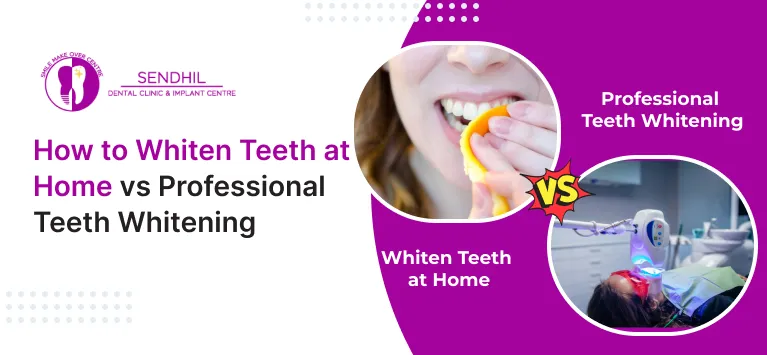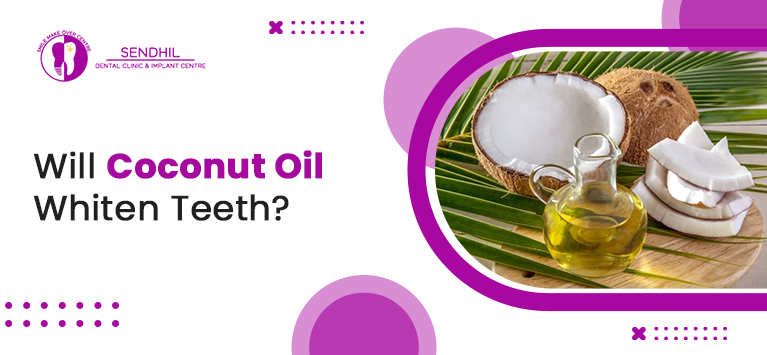
How to Whiten Teeth at Home vs Professional Teeth Whitening
A bright, white smile is often seen as a sign of good health and confidence. Many people explore ways to whiten their teeth, but the choices can feel overwhelming. Should you try to whiten teeth at home with natural remedies or invest in professional teeth whitening for faster results?
In this blog, we’ll break down the different options for teeth whitening, including natural methods, dentist-supervised treatments, costs, and what results you can realistically expect.
Table of Contents
What is Teeth Whitening?
Teeth whitening is a cosmetic process that lightens the shade of your teeth by removing stains and discoloration. Whether you try how to whiten teeth naturally at home or book a dentist whitening treatment, the goal is to achieve a brighter, healthier-looking smile.
Teeth can become stained over time from factors like
- Drinking coffee, tea, or red wine
- Smoking or tobacco use
- Aging
- Certain medications
Understanding the cause of discoloration can help you decide the best approach to how to get white teeth.
60% of people believe a whiter smile improves their confidence and appearance
How to Whiten Teeth at Home?
Many people look for ways to whiten teeth at home because it’s more affordable and convenient than visiting a clinic. From over-the-counter products to natural remedies, there are several safe and effective options you can try.
1. Whitening Toothpastes and Strips
These are among the most accessible and affordable options.
- Whitening toothpastes contain mild abrasives and small amounts of peroxide that help remove surface stains over time.
- Whitening strips are thin, flexible pieces coated with a whitening gel (usually hydrogen peroxide) and are applied directly to the teeth for a set time each day. Results may take a few days to a couple of weeks.
2. Whitening Trays
Some at-home kits include trays filled with a peroxide-based gel.
- These trays fit over your teeth and are typically worn for a few hours daily for 1–2 weeks.
- Custom-fit trays (usually from a dentist) tend to offer better coverage and even whitening than generic ones.
3. LED Whitening Kits
LED whitening kits are gaining popularity.
- They use a combination of whitening gel and a blue LED light to accelerate the whitening process.
- These kits are easy to use and often show visible results after a few sessions, although consistency is key.
How to Whiten Teeth Naturally at Home
If you prefer a more natural or chemical-free approach, there are remedies using common household ingredients. While results may be milder and take longer, they can still be effective with regular use.
1. Baking Soda and Water
Baking soda is mildly abrasive and helps scrub away surface stains.
- Mix a small amount with water to form a paste.
- Use it 2–3 times a week, but avoid overuse as it can wear down enamel.
2. Hydrogen Peroxide
Hydrogen peroxide has bleaching properties.
- Use a diluted solution (equal parts water and 3% hydrogen peroxide) as a mouth rinse for 30–60 seconds.
- Use only a few times per week to prevent gum irritation.
3. Oil Pulling (with Coconut Oil)
This ancient practice may improve oral hygiene and reduce surface staining.
- Swish 1 tablespoon of coconut oil in your mouth for 10–15 minutes.
- Spit it out and rinse with water before brushing.
Also Read: Will coconut oil whiten teeth?
4. Strawberries and Baking Soda
Strawberries contain malic acid, which may help reduce staining.
- Mash one ripe strawberry and mix it with baking soda.
- Apply the paste to your teeth for 5 minutes, then rinse and brush.
Also Read: Dental health benefits of strawberries
5. Maintain Good Oral Hygiene
Regular brushing and flossing are the foundation of whiter teeth.
- Brush at least twice daily with fluoride toothpaste.
- Floss once a day to remove plaque and prevent staining between teeth.
6. Limit Stain-Causing Foods and Drinks
Certain foods and drinks can stain your teeth over time.
- Cut back on coffee, tea, red wine, cola, soy sauce, and dark berries.
- If you consume them, rinse your mouth with water afterward or brush after 30 minutes.
7. Use a Straw
Using a straw can minimize the contact of staining liquids with your teeth.
- This tip is particularly helpful for iced coffee, tea, and soda.
8. Eat Crunchy Fruits and Vegetables
Apples, carrots, and celery help clean your teeth naturally while you chew.
- These foods also stimulate saliva, which helps wash away debris and acids.
Also Read: 12 fruits and vegetables to snack your way to whiter teeth
9. Chew Sugar-Free Gum
Sugar-free gum promotes saliva production.
- Saliva helps neutralize acids, wash away food particles, and keep your teeth cleaner.
10. Try Apple Cider Vinegar (Diluted)
Heavily diluted apple cider vinegar may help brighten your teeth.
- Use it occasionally as a mouth rinse, but not daily — its acidity can erode enamel with frequent use.
11. Avoid Smoking or Tobacco
Smoking and tobacco use can cause deep stains that are hard to remove at home. Quitting smoking improves both oral health and tooth color.
Note: Use all natural remedies cautiously and in moderation. Overuse, especially of acidic or abrasive items, can damage enamel.
Professional Teeth Whitening
Professional teeth whitening is performed by a dental expert using stronger agents than at-home kits. It offers faster and more noticeable results.
You might choose this if you have
- Deep or stubborn stains
- An upcoming special event
- Sensitive teeth require careful supervision
Treatments like one hour teeth whitening dentist services can dramatically whiten teeth in a single session.
Professional whitening can lighten teeth up to 8 shades in one hour.
Professional Teeth Whitening Cost
One of the most common questions is, how much is professional teeth whitening? On average:
| Treatment Type | Estimated Cost (INR) |
| In-office Whitening | ₹33,400 – ₹66,800 |
| Custom Take-home Trays | ₹25,000 – ₹50,000 |
| Laser Whitening | ₹50,100 – ₹83,500 |
If you’re wondering how much does professional teeth whitening costs, it’s important to note that prices vary based on location, technology, and the experience of the best teeth whitening dentist you choose.
While the professional teeth whitening cost is higher than DIY methods, the results tend to be faster, brighter, and longer-lasting.
Professional Teeth Whitening Before and After: What to Expect
Professional teeth whitening before and after results can be impressive. Most patients notice their teeth are 5–8 shades whiter after just one treatment.
The process usually involves:
- Initial cleaning
- Application of whitening gel
- Activation with a special light or laser
- Post-treatment care instructions
Choosing a teeth whitening dentist ensures that the treatment is safe, effective, and customized to your needs.
How Long Does Professional Teeth Whitening Last?
Many people ask, how long does professional teeth whitening last? With good oral hygiene and lifestyle habits, the results can last from 6 months up to 3 years.
Factors that affect longevity include:
- Avoiding staining foods and drinks
- Not smoking
- Regular dental cleanings
- Occasional touch-up treatments
A dentist whitening treatment can help maintain your results over time, keeping your smile bright for longer.
Does Professional Teeth Whitening Work?
In short: absolutely. Does professional teeth whitening work? Yes, and it typically works far better than over-the-counter options.
Studies show that professional teeth whitening can make teeth several shades whiter in just one session. In contrast, at-home methods might take weeks and may only remove surface stains.
The key difference? Teeth whitening professional treatments use concentrated, dentist-monitored agents to safely deliver maximum results.
How to Whiten Teeth at Home vs Professional Teeth Whitening
To make it easier, here’s a quick comparison:
| Feature | How to Whiten Teeth at Home | Professional Teeth Whitening |
| Cost | ₹1,670 – ₹16,700 | ₹33,400 – ₹66,800 |
| Speed of Results | Slow (Weeks to Months) | Fast (1–2 sessions) |
| Effectiveness | Mild to Moderate whitening | Significant whitening (up to 8 shades lighter) |
| Supervision | No professional supervision | Done by a trained teeth whitening dentist |
| Methods Used | Natural remedies, whitening strips, DIY trays | Laser whitening, custom trays, high-concentration gels |
| Longevity | 1–6 months (needs touch-ups) | 1–3 years (with proper care) |
| Safety | Risk of misuse (overuse can damage enamel) | Safer under a dentist’s care |
| Convenience | Done anytime at home | An appointment is needed at the dental clinic |
| Sensitivity Risk | Higher if used incorrectly | Managed carefully by a dentist |
| Customization | One-size-fits-all kits | Personalized for your teeth shade and needs |
| Time Taken per Session | 10–30 minutes daily (at home) | 45–90 minutes (clinic visit) |
| Examples | Baking soda, coconut oil pulling, and store-bought whitening strips | Zoom whitening, laser whitening, one-hour teeth whitening dentist treatments |
If you’re seeking fast, dramatic results, visiting the best teeth whitening dentist may be the best choice. But if you’re looking for gradual improvement and cost savings, learning how to whiten your teeth at home could be more suitable.
Conclusion: Choosing the Right Whitening Approach
Whether you explore how to whiten teeth at home with natural methods or decide to invest in professional teeth whitening, achieving a brighter smile is possible.
If you need fast, significant results and professional care, consulting a teeth whitening dentist for a dentist whitening treatment is recommended. For those wanting gradual improvements, natural remedies and at-home kits offer a gentler path.
Ultimately, both approaches have their benefits. Knowing your goals, budget, and dental health can help you choose the right method to achieve the smile you want.








